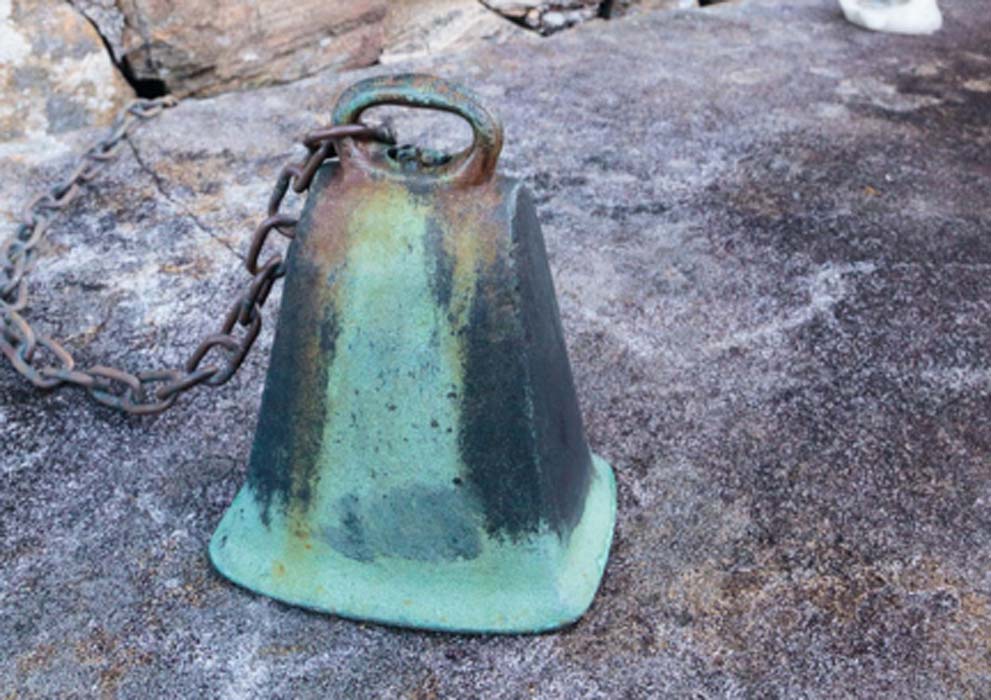Ancient Scottish Church Bell Stolen from Sacred Island Leaving Locals Devastated
A sacred symbol of Scottish identity, a late medieval bell, has been stolen from a remote ruined chapel on an uninhabited Scottish isle which featured as the ‘Black Lake’ in the Harry Potter films.
History experts in Lochaber on the west coast of Scotland told The Oban Times that the thieves “launched an amphibious raid” on St Finan’s Isle, which is a tiny idyllic islet on Loch Shiel made famous in the Harry Potter movies, “and stole a rare medieval bell.” At the summit of the isle are the ruins of St Finan's chapel, which was built in about 1500 AD by the chief of the Clan Ranald and it lay in ruins when Bonnie Prince Charlie passed by in 1745 ADon his way to Glenfinnan at the head of the loch where he famously raised his standard.

The ruins of the church with the stolen bell on its altar. (National Archives/CC BY NC)
St Finan was born in Ireland and is thought to have lived between between 520 and 600 AD and several churches and sacred places in Scotland and Ireland are named after this Columban-trained monk. The tiny Isle has been a sacred Christian burial ground dedicated to his good name since the late 7th century.
- Witchcraft? Tributes to Murder Victims? The Uncertain Origins of 17 Miniature Coffins in Scotland
- Archaeologists in Scotland Unearth a Neolithic “Network” of Ancient Sites
- Archaeologists Say They Have Found an Important Medieval Site Linked to Scottish Hero William Wallace
An MSN news report, and most others you will read, open with the somewhat predictable story about the “cursed historic bell”, a storyline inspired by members of the Moidart History Group, who said it was “reputed to be cursed and was last stolen by a soldier in the 1740s’ who was subsequently captured and flogged and the bell was returned to the island by his officers.” However, the ‘curse’ aspect is mere pop-cultural fog in comparison to the religious and mythological loss this theft is to Scotland and its people.
Ancient Origins of the Church Bell
To get to the heart of the sacred significance of bells in Christianity we must refer to The Book of Genesis in which Tubal-Cain’s brother Jubal built a bell after hearing his brother’s hammer ringing on his iron anvil. Large church bells, like the one that’s been stolen, were not invented until the mid-5th century by the missionary St. Paulinus in Campania. Incidentally, this is where the term ‘campanology’ is derived, which encompasses not only the casting and tuning technologies required to make bells, but also the history, skills, and methods of the art of bell-ringing.

“Bells were anointed with both holy water and holy oil in the sign of the cross, in order to make the Devil flee when the bells were sounded”. (Himchenko /Adobe Stock)
Large bells came into widespread use in Scotland in the 7th century and were used to call the faithful from their fields to prayer on religious days, births, marriages, and deaths. However, an article on Folk Lore Thursday explains that a Christian ceremony from 1700 AD says “bells were anointed with both holy water and holy oil in the sign of the cross, in order to make the Devil flee when the bells were sounded”. And when women were in labor, church bells were sometimes tolled “(for a fee)” in order to speed their delivery.”
The Brainless Bell Raiders
This theft was no act of casual vandalism performed by your average gang of bored miscreants; it was a carefully orchestrated artifact crime and a direct attack at the cultural heart of Scottish and Irish people. While the bell has no monetary value if melted down and sold, it holds much religious, historical, and cultural significance for the surrounding population.
St Finan’s Isle is remote, and until a sharp increase in kayaking in 2016 brought visitor numbers to around 2000, only a handful of people landed on the island every year. In 2017, authorities replaced the old thin security chain with a “hand-forged bronze chain” which must have required heavy duty chain cutters to have severed. This exact tactic was deployed in 2017 when another sacred bell was stolen from Fortingall Church in Perthshire in Scotland - suggesting Saint Finan's Bell might have been stolen to order. Which is just a horrible thought.

View of Glenfinnan monument and Loch Shiel. (Gil Cavalcanti/CC BY SA 3.0)
International Church Bell Gangs
The theft of church bells is not restricted to the UK’s criminal underworld, and it was only last year NBC Connecticut reported that “a century-old 300-pound bell” was stolen from the Nativity of the Holy Virgin Mary Orthodox Church in Waterbury. And just like in Scotland, the thief/thieves cut the security chain with heavy duty equipment; in this case "a die grinder.”
- 3,000-year-old broken weapons found in Scotland loch reveal ancient ritual offerings to gods
- Forgotten Kings and Queens: The Lost Gypsy Dynasty of Scotland
- The Impressive Gaulcross Hoard: 100 Roman-Era Silver Pieces Unearthed in Scotland
And if you are in any doubts as to the powerful unifying spirit of a church bell in ancient times, this April 2019 Daily Mail article tells of “the bells of Westminster Abbey ringing out in solidarity with all the church bells in France” after the devastating fire that gutted Notre Dame Cathedral, horrifying the world. Imagine now the dewey heather crusted glens of ancient Scotland or Ireland, early on a Sunday morning, vibrating under the unifying sounds of bells. Well it’s part of that ancient sacred melody that has been stolen from the Scots and Irish.
If you might have information pertaining to this theft, or the whereabouts of the bell, please call ‘101’ and quote incident ‘2838 of July 18’ or alternatively call Crimestoppers anonymously on 44 800 555 111.
Top Image: St Finan’s Bell. Credit: Seakayaphoto.com
By Ashley Cowie



















